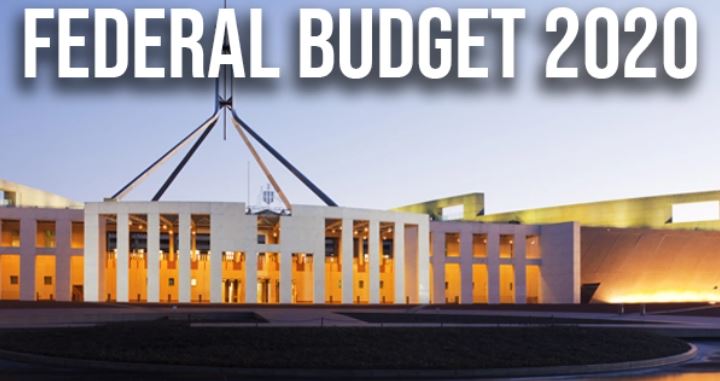It is a Budget without precedent, for a year unlike any other. Here are the basics you should know about the 2020 Federal Budget and how it will affect you.
The Federal Budget takes a deep look into how the COVID-19 global pandemic has affected Australians — and what is being done to get our economy running again.
Here’s a guide to what you need to know about the 2020 Federal Budget.
THE ECONOMY
$213.7b
The total deficit for 2020/21 with the forecast to still be $66.9b by 2023-24 financial year. Net debt will be 36 per cent of GDP this year, peaking at 44 per cent of GDP in June 2024.
Government to raise the debt ceiling to $1.1 trillion.
TAX
* $2745 in tax relief for low and middle-income earners, while households will get up to $5490.
* The 19 per cent tax rate threshold will be increased from $37,000 to $45,000. The 32.5 per cent tax threshold will be increased from $90,000 to $120,000.
* A capital-gains tax exemption created for granny flats provided a written agreement is in place
* The ATO has been given an additional $15.1m to target crime in the tax and superannuation systems.

EDUCATION AND TRAINING
* $1.2b package for Australian businesses to employ 100,000 new apprentices and trainees
* $326m provided for 12,000 new domestic university placements
* $550m for universities to provide 50,000 new higher education short courses in agriculture, health, IT, science and teaching
* The fringe benefits tax that applied to businesses retraining workers has been scrapped
* The Smith Family charity will get $38m to help Australia’s poorest students finish high school.
ENVIRONMENT
* $249m boost for water and recycling industry, with another $103m for a National Radioactive Waste Management Facility at Napandee, near Kimba, South Australia
* Farmers and communities still struggling with the effects of the drought will be supported by $155.6m over four years.
* $233m for Uluru, Kakadu, Christmas Island and Booderee National Parks will receive $233m in funding, with $47.4m over four years for ocean health initiatives
HEALTH AND WELFARE
* $2.6b for five million pensioners and the unemployed who will pocket $500 in bonus payments ($250 in December and $250 in March).
* Thousands of new mums will qualify for paid parental leave even if they’ve been stood down during the pandemic (Usually they must be in paid work to qualify).
* No new childcare initiatives but record spending of $9bn next financial year.
* Funding for 23,000 new home care packages for older Australians

* Elderly Australians with a disability who can’t get access to the NDIS will get help from a new $125 million program.
* Aged care homes will get $750 million to help them manage COVID including workforce retention bonuses, infection control and training for nurses.
* $7.6 million for parents experiencing stillbirths or death of a child under 12 months
* $60 million for DV “safe places” initiative
* $9 million for research into cancer in children and young adults
* Adult children will be allowed to stay on their parents’ private health fund accounts until the age of 31
* Medicare funded mental health consults will double from 10 to 20
TOURISM
* $250 million program to encourage regional tourism
* $233.4 million over three years from 2021 to improve infrastructure in Commonwealth national parks. Hopes to improve tourism draw of these “internationally iconic places”.
* $6 million over two years from 2020-21 to support local tourism operators and encourage tourism to the Great Barrier Reef.
JOBS AND WORKERS
* Budget papers predict spending on dole payments will soar to a staggering $41b in 2020/21 but almost halve to $22bn a year later.
* Under new reforms new superannuation accounts will no longer be created each time a worker starts a new job – instead the person’s super account will follow them to their next gig.
* JobKeeper to end March 28, 2021 but a “back-to-work” wage subsidy scheme for businesses employing Australians under 35 who have been forced onto welfare payments.
* No change to JobSeeker rate
INFRASTRUCTURE
* $10b allocated in infrastructure spending, including $7.5 billion in road and rail projects spread across all states and territories
* Australia’s domestic fuel security will benefit from $211m in funding while another $53m set aside for gas infrastructure

BUSINESS AND MANUFACTURING
* $1.5 billion allocated for manufacturing in six target areas: space, medicine, food and beverage, defence, resources tech, recycling and clean energy
* $800 million aimed at helping businesses work online, including $29.2m to boost early business access to the 5G network
* An additional 10,000 places have been created in the First Home Loan Deposit Scheme
* $419.9m allocated for upgrade of government’s business register
* The ATO will offer simplified GST accounting methods for businesses with turnovers under $50m
* Fringe Benefits Tax to be removed for many businesses. Companies with turnovers of between $10m and $50m will be able to access up to 10 small business tax concessions
TECHNOLOGY
* $4.5bn NBN upgrade will replace copper lines and older hardware. The upgrade, which will unlock download speeds of up to one gigabit per second for millions more fixed-line users, will take place over the next three years.
* High-speed 5G technology, which could compete with the NBN, also received a boost, with the government committing $29.3m for 5G trials in industries including agriculture and manufacturing

$1.67b has been earmarked for the government’s cyber security strategy
* $260m has been allocated for the digital identity system for businesses
* The government will pay compensation of around $3b to Australians and citizens of other countries “for damage caused” by our national space program.
DEFENCE
* $101.7m allocated over four years for veterans’ mental health support and services.
* Infrastructure programs for Pacific allies have been funded to the tune of $124m over 10 years. Among other projects, Australian will construct a border and patrol boat “outpost” on the Solomon Islands.
REGIONAL AUSTRALIA
* $100m allocated for the Regional Recovery Partnerships program, including $30m Regional Connectivity Program and $200m for the Building Better Regions Fund
* Farmers will be able to access $50m in rebates for putting in bores and dams
Courtesy of Herald Sun


